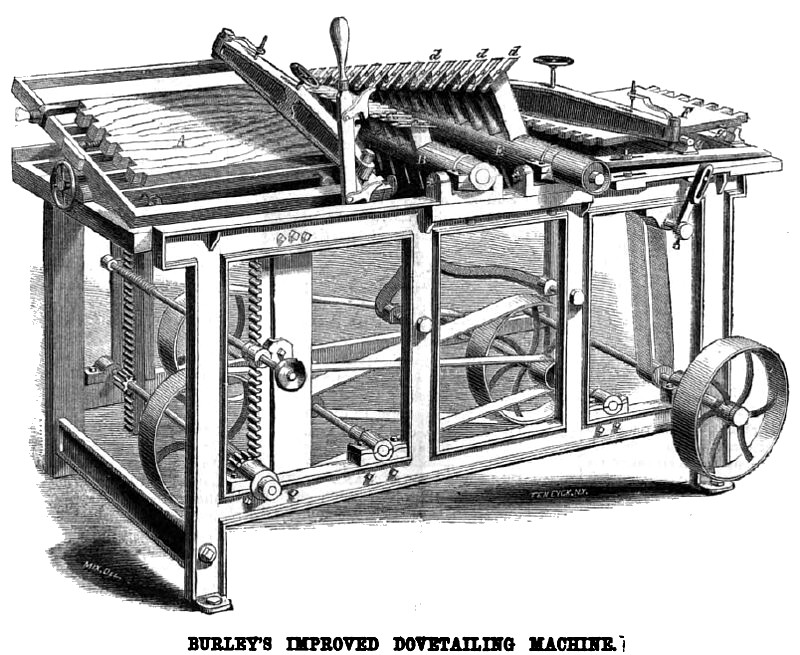|
Title: |
1860 Article-Burley & Putnam, Dovetailing Machine |
|
Source: |
Scientific American, V 2 #13, 24 Mar 1860, pg. 193 |
|
Insert Date: |
11/24/2014 12:59:46 PM |
IMPROVED DOVETAILING MACHINE.
We here present an illustration of one of those machines for working wood, which, including the Woodworth planer and all the other important improvements in this department, have probably accomplished more labor and contributed more to develop the resources of the country than any other class of inventions. This dovetailiug machine, though, of course, of immensely less importance than the planer, is still among the most valuable machines of its class, and it is interesting to all mechanicians from the simplicity of its parts and the perfection of its operation. The dovetailing of furniture and boxes by hand is a slow process, requiring the attention of skilled and careful workmen, but it is performed by this machine with all the accuracy characteristic of machine work and with a rapidity perfectly surprising.
In dovetailing, two kinds of notches or grooves must be cut, those in one board expanding from one side of the board to the other, while in the board w h i c h matches these the notches must expand from the end of the board inward. A represents a board placed in position to cut the grooves expanding from its upper to its lower side, the series of cutters, c c, being secured to the rapidly revolving shaft, B. The board, A, is placed upon a frame inclined at the de sired angle and slowly fed upward past the revolving cutters which form one half of the groove, the inclination of the board causing the outer edge of the groove to have the proper angle. When the board has been carried upward past the cutters, the feed motion is automatically thrown out of gear and the board, with the frame, drops back again below the cutters, at the same time being tipped at an equal angle in the Opposite direction; when the feed, resuming its action, carries the board and frame again upward past the cutters, which take out the other half of the grooves, giving their sides an inclination in the opposite direction to the inclination of the sides first formed, so that the grooves expand downward in the proper shape.
For forming the second class of grooves, or those which expand from the end of the board inward, the cutters, d d d, are rigidly secured upon the revolving shaft, E, the lengths of the arms which carry them being gradually increased from one end of the shaft to the other, so that the cutters may run in a line diagonal to the frame of the machine. The board F, is placed upon the machine and automatically fed forward end-wise to the cutters, which take out one-half of each groove, when the board is turned over and, by a similar operation, the groove is completed by cutting the other half; the inclined position of the cutters, it will be seen, causing the grooves to expand inward from the end. The board, of course, must be placed upon the frame at an angle in order to bring its end parallel with the line of the cutters. This angle is readily adjusted to correspond with the angle in the grooves of the board, A, by means of the screws, g g. The several motions described are effected by well-known mechanical devices. There are two and perhaps three large fields for the employment of this dovetailing machine. One is in the manufacture of boxes for the army and navy, all of which are required to be dovetailed in order to resist the very rough usage to which they are exposed. A still larger field than this is in cabinet-making, which, in itself, is of inconceivable extent. But the inventor is entirely confident that packing boxes can be made by it at a cost which will enable them to be sold as low as the nailed boxes, and of a strength which will save the considerable expense of hooping. In any event the machine is of immense value, and if it answers well for all the purposes named, it will, in old Dr. Johnson's language, “ Confer the potentiality of acquiring wealth beyond the dreams of avarice.”
The American patent for this invention was obtained, through the Scientific American Patent Agency, Jan. 3, 1860. Applications for patents are also pending in foreign countries. Further information in relation to the invention may be obtained by addressing the inventor, Thomas H. Burley, at No. 195 Sixth-Avenue, this city.
US Patents: 12,122 & 26,647 |
|
 1860 Burley & Putnam, Dovetailing Machine
1860 Burley & Putnam, Dovetailing Machine
|
|